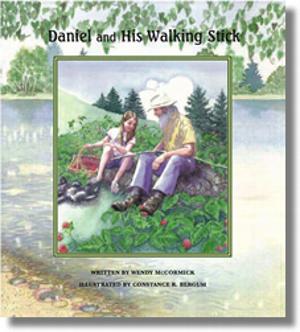 |
| Peachtree Publishers |
|
Our Winning Book Synopsis:
This is a book about a girl named Jesse who missed the opportunity to know her two grandfathers. During one summer’s country vacation, her mother introduces her to an old man who actually knew one of Jesse’s grandfathers. This bearded man, Daniel Stockton, loves to go walking in nature and he uses a natural walking stick wherever he goes.
To Jesse, Daniel himself looks like a tree, and that branch-like pole in his hand intrigues Jesse immensely. They spend their summer days together observing fish, crossing streams, watching birds, probing woodchuck holes, picking wild raspberries, and getting muddy shoes. For all of these activities, Daniel demonstrates how a walking stick can be used as a water gauge, pointer, balance preserver, berry picker, hole probe, nest inspector, and shoe scraper.
Thus Jesse considers a walking stick to be a mandatory tool for hiking and exploring nature. She wants one too! One day when they were hiking near the lakeshore, Daniel showed her where he found his own walking stick, and he finds one for Jesse too.
She is thrilled to finally have her very own walking stick. She takes it home with her at the end of the summer, and even uses it in her city life to rekindle her pleasant summer memories of nature exploration. She proudly demonstrates some of its many uses to her Mom as they walk in the city. She now likes to think of Daniel as her “third grandfather”—the one who has a walking stick just like hers.
We liked this book because it shows how, when all is as it should be, one generation passes on its love of nature to the next. Author Wendy McCormick’s text represents both a young girl’s innermost thoughts and her external dialogue. Her text touches both the mind and the heart. She knows how to be concise and how to evoke empathy.
Her words are in balance and harmony with illustrator Constance R. Bergum’s sunny and inviting water color artwork. Bergum is indeed a maestro in capturing natural light, wind, water, and the summertime mood on paper. She also knows how to paint detailed but edited swatches of scenes that involve and enable the mind to complete the picture. Her carefully planned, low angle perspectives give us a magnified, child’s-eye view of summer fun. Her snapshot-like collages create a “time-series effect” that dilates the present into a multifaceted past. She sees and recreates the simple, natural, authentic beauty in people and environments, rather than painting ideal landscapes, or depicting adults, animals, plants, and children too pretty to be believed.
Many children aged 4 to 8 today are cocooned indoors. How can we separate them from their color televisions, movies, and video games? What would make them want to go outdoors and explore the natural world? We think the answer is--a book like this one. McCormick’s simple but cleverly enticing device is the walking stick and Bergum “sells” the idea visually. Who could read this book and not simply want but actually require a natural walking stick to turn every hike into an adventure? The natural scientific observations that the stick enables in this story help comprise the experiential basis of a scientific understanding. Leonardo da Vinci is said to have done the same thing in his youth near his home town of Vinci in Italy. Tools like the naturalist’s walking stick and canteen can serve as outdoor-appropriate tools, stimuli, and invitations to scientific curiosity and inquiry in nature.
We hope every child who reads this book is so fascinated by the idea of a walking stick that they will be moved to value, investigate, and enjoy the outdoor physical and living worlds of nature. We hope that every child who reads this book seeks out and values the teachings and wisdom of his/her elders about nature. We think this book is the perfect gift by uncles, aunts, neighbors, and grandparents for any child who may be afflicted by what an adult book author, Richard Louv, has called “nature deficit disorder.” Louv uses that term to describe “an environmental ennui flowing from children's fixation on artificial entertainment rather than natural wonders.”
This is a book a child will ask to read again and again. Why? Because it is full of possibilities and play-time ideas. Plus, you don’t have to be on a team of nine and wear a uniform to participate. We think this is a more appropriate science book for young children than one crammed full of detached facts about, say, snakes or beavers. This book has a story and characters and a plot. It teaches about relationships with people and with nature. It conveys attitudes and it demonstrates how one can explore nature and involve all of one’s senses—directly!
|